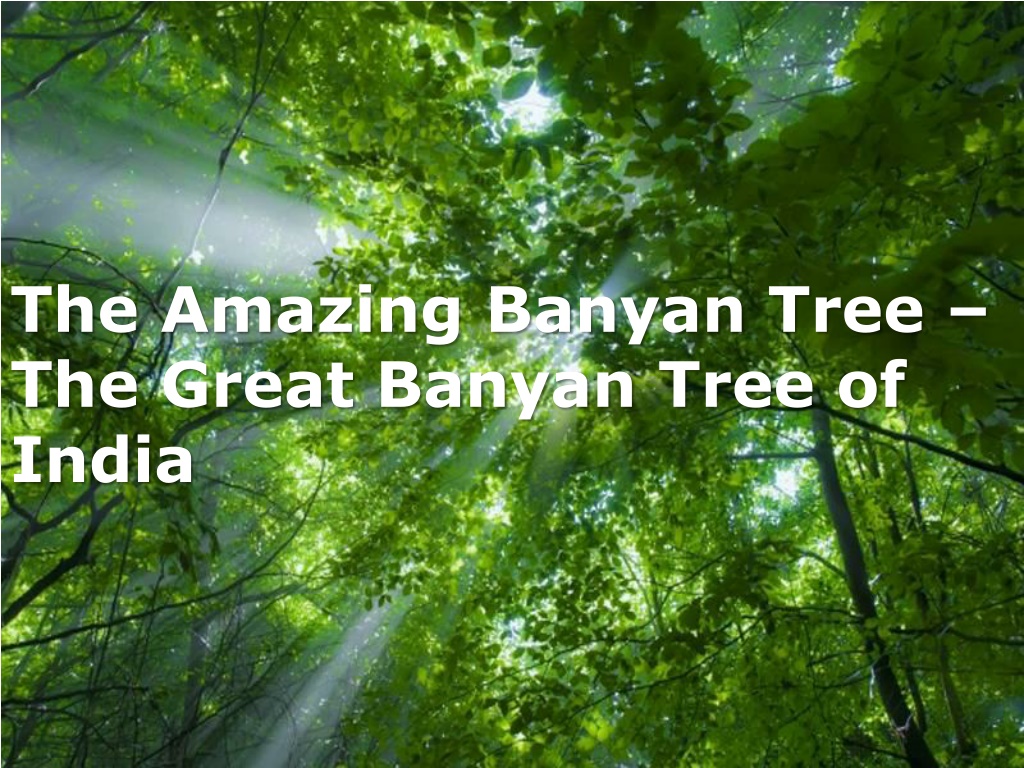The Amazing Banyan Tree of India: A Natural Wonder
Discover the extraordinary banyan tree, also known as the great banyan tree of India. Learn about its unique life cycle, aerial prop roots, and significance as the National tree of India. Explore the fascinating attributes of this majestic fig tree, from its epiphyte stage to the growth of strangler roots. Dive into the lush green leaves and intricate fruit structures that make the banyan tree a botanical marvel.
Download Presentation

Please find below an Image/Link to download the presentation.
The content on the website is provided AS IS for your information and personal use only. It may not be sold, licensed, or shared on other websites without obtaining consent from the author. Download presentation by click this link. If you encounter any issues during the download, it is possible that the publisher has removed the file from their server.
E N D
Presentation Transcript
The Amazing Banyan Tree The Great Banyan Tree of India Free Powerpoint Templates Free Powerpoint Templates Page 1
A banyan (also banian) is a fig that starts its life as an epiphyte when its seeds germinate in the cracks and crevices on a host tree (or on structures like buildings and bridges). specifically to the Indian benghalensis, the National tree of India, though the term has been generalized to include all figs that share a unique life cycle, and systematically to refer to the subgenus Urostigma. The seeds of banyans are dispersed by fruit-eating birds. The seeds germinate and send down roots ground, and may envelop part of the host tree or building structure with their roots, giving them the casual name of "strangler fig." The "strangling" growth habit is found in a number of tropical forest species, particularly of the genus Ficus, that compete for light. Any Ficus species showing this habit may be termed a strangler fig. "Banyan" Banyan often refers Ficus or towards the Free Powerpoint Templates Page 2
Epiphyte stage Free Powerpoint Templates Page 3
The leaves of Banyan tree are large, leathery, glossy green and elliptical in shape. Like most of the fig-trees, leaf bud is covered by two large scales. As the leaf develops the scales fall. Young leaves have an attractive reddish tinge Free Powerpoint Templates Page 4
Free Powerpoint Templates Page 5 Flower
Free Powerpoint Templates Page 6
Free Powerpoint Templates Page 7
Older banyan trees are characterized by their Aerial prop roots that grow into thick woody trunks which, with age, can become indistinguishable from the main trunk. Old trees can spread out laterally using these prop roots to cover a wide area. Like other Fig species (which includes the common edible fig Ficus carica), banyans have unique fruit structures and are dependent on fig wasps for reproduction. Free Powerpoint Templates Page 8
Early stages of a strangler fig on a host tree in the Western Ghats, India. Free Powerpoint Templates Page 9
Large banyan tree in Punjab, Pakistan. Free Powerpoint Templates Page 10
Free Powerpoint Templates Page 11
Free Powerpoint Templates Page 12
The Great Banyan of India The Great Banyan is a banyan tree (Ficus benghalensis) located in Acharya Jagadish Chandra Bose Indian Botanic Garden, Howrah, near Kolkata, India. It was the widest tree in the world in terms of the area of the canopy and is estimated to be about 200 to 250 years old. It became diseased after it was struck by lightning, so in 1925 the middle of the tree was excised to keep the remainder healthy; this has left it as a clonal colony, rather than a single tree. A 330 m long road was built around its circumference, but the tree continues to spread beyond it. Free Powerpoint Templates Page 13
Free Powerpoint Templates Page 14
Free Powerpoint Templates Page 15
History The tree is over 250 years old and in spread it is the largest known in India, perhaps in Asia. There is no clear history, but it is mentioned in some travel books of the 19th century. It was damaged by two great cyclones in 1884 and 1886, when some of its main branches were broken and exposed to the attack of a hard fungus. With its large number of aerial roots, It looks more like a forest than an individual tree. It now lives without its main trunk, which decayed and was removed in 1925. The circumference of the original trunk was 1.7 m and it was 15.7 m. tall. The area occupied by the tree is about 14500 square m. (or 4 acres). The circumference of its crown is about 1 kilometre and the highest branch rises to about 25 m; it has at present 2880 aerial roots Free Powerpoint Templates reaching down to the ground. Page 16
Free Powerpoint Templates Page 17
Free Powerpoint Templates Page 18
Free Powerpoint Templates Page 19
Free Powerpoint Templates Page 20
Free Powerpoint Templates Page 21
Free Powerpoint Templates Page 22
Free Powerpoint Templates Page 23























